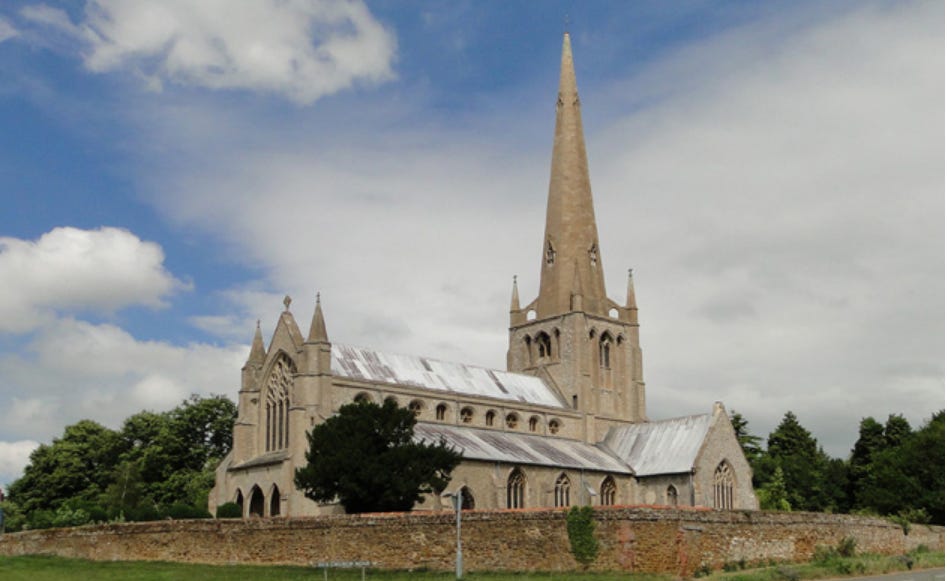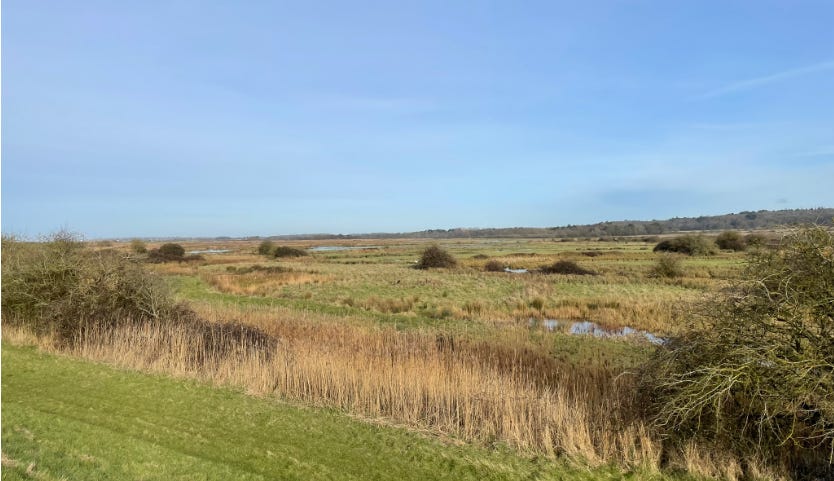About five kilometers to the north of Dersingham, the high land of Ken Hill rises above the marshes. To reach it, we walk the line of the railway that once ran from King’s Lynn to Hunstanton, with four village stops in between. Nearly a hundred years ago, my father – beginning at age eleven – rode the train twice daily, to and from Lynn, where he attended grammar school.
The footpath runs behind houses, and then between the alder and willow stands of Life Wood, blending seamlessly into Ingoldisthorpe Common and then wide pastures to the west, between the path and the A149. There’s usually fair birding along here: finches and tits near the houses; green woodpecker and curlew in the pastures, sometimes oystercatchers. Buzzards hunt the rabbits, and red kites soar, hoping for roadkill. (The muntjac fulfill that hope, in spades.)
At the edge of Snettisham the line of the railway becomes private land again and we make a detour through the village, cross the A149, and enter the pine plantations of Ken Hill itself. It’s not a birdy place, although greater spotted woodpecker and tits of all sorts aren’t uncommon. The pine needles underfoot make for quiet walking.
To the north of the footpath that leads into Lodge Hill, the southernmost of the two promontories here, the hoards for which Snettisham is known (at least among archaeologists and history nerds) began to be discovered in the late 1940s, the fields then under plough. The ploughman that found the first piece thought that he had ploughed up part of a brass bedstead. The ‘Snettisham Treasure’:
‘represent(s) one of the largest collections of prehistoric precious metal objects ever discovered, and one of the largest concentrations of Celtic art. The objects were found in at least 14 separate hoards buried between 150 BC and AD 100 – spanning the late Iron Age and early Roman periods, but with a peak of activity during the late Iron Age.’ 1

At its southwestern edge the vista of the fields and marshes opens up. Here on the hill’s height are the remains of a tower, possible a medieval watchtower, possibly a warrener's lodge. Beyond it are arable fields, and beyond those, the marshes, full of waterfowl and wetland birds, marsh harriers and barn owls, the occasional peregrine. Closer to the Wash, it’s possible to walk part of the sea defense dyke for a closer look at the wintering waterbirds, and the Chinese water deer and muntjac that graze here. Between the dyke and the beach are the remains of gun emplacements from the second world war, crumbling into the shingle and scrub.
Turning east instead of west, we walk towards the high greensand ridge that parallels the Wash, where the thirteenth century Snettisham church stands. Already on high ground, its steeple – a rarity in Norfolk – makes it visible from land or sea for long distances. (The church – or at least its grounds - was hit by a German airship bomb in the first World War, an event which plays a part in short story of mine, to be published in an anthology from Taw River Press later this year.)

Just a kilometer or less south of the church, a Roman villa stood, one of several along the greensand ridge. The last hoard discovered in Snettisham, in 1985, is considered to be a Roman jeweler’s hoard – consisting of silver and 110 intaglios and various other pieces dated to the 2nd century AD.
At the Roman villa site – nothing to see now, but I like knowing it’s there, its mosaic floor and walls lying below the pasture – we have two choices: a footpath down towards the river Ingol, through a field of sheep, and up again a steep hill into Ingoldisthorpe village, or, a bridleway that is gentler on aging knees. We choose the latter. The Ingol is wooded on either side, another good place for tits and dunnock, jays and magpies. This is frequently the first place we find chiff-chaff in the spring, and the water treatment ponds here are reliable for wagtails, pied and often one lone grey wagtail, but the black-headed gulls have congregated, bullying the other birds away.
Permissive paths take us past a marlpit, now filled with trees, and across the old allotment grounds – where, to our delight, the first butterfly of the year, a peacock, flutters by. Two hares are boxing in the field of winter cereals, and a red kite is perched on a pole. We walk down a steepish lane where grain mills once stood, past the lumps and bumps of medieval water management in the neighbouring fields (which almost always have curlews), past the 17th century tithe barn and the jackdaws playing around the tower of the church where my great-grandparents are buried, and home again.

Or not, because next-door-but-one is a lovely Victorian pub!





